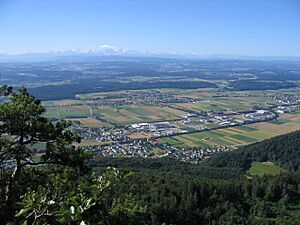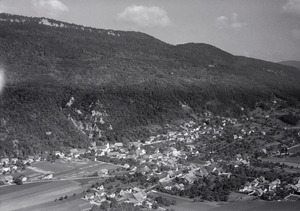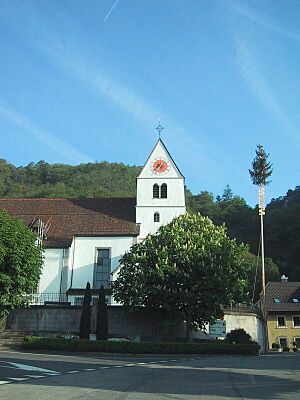Egerkingen facts for kids
Quick facts for kids
Egerkingen
|
||
|---|---|---|

Old Mill in Egerkingen
|
||
|
||
| Country | Switzerland | |
| Canton | Solothurn | |
| District | Gäu | |
| Area | ||
| • Total | 6.95 km2 (2.68 sq mi) | |
| Elevation | 440 m (1,440 ft) | |
| Population
(Dec 2020 )
|
||
| • Total | 4,041 | |
| • Density | 581.4/km2 (1,505.9/sq mi) | |
| Postal code |
4622
|
|
| Surrounded by | Gunzgen, Hägendorf, Härkingen, Holderbank, Langenbruck (BL), Neuendorf, Oberbuchsiten | |
Egerkingen is a town, known as a municipality, in Switzerland. It is found in the Gäu area of the canton of Solothurn.
Contents
History of Egerkingen
Egerkingen was first mentioned in old records way back in 1201. At that time, it was called in Egrichen. A few years later, in 1212, its name changed slightly to in Egerchingen.
Geography of Egerkingen
Egerkingen covers an area of about 6.94 square kilometers (2.68 sq mi). This is roughly the size of 1,700 football fields!
A big part of this land, almost half (49.6%), is covered by forests. About a quarter (24.8%) is used for farming, like growing crops or raising animals. The rest of the land (25.1%) has buildings, roads, and other developed areas. A very small part (0.3%) is made up of rivers.
The town is located in the Gäu district. It sits at the bottom of the Jura Mountains, a mountain range in Switzerland. It's also found between two other towns, Olten and Oensingen.
Egerkingen's Coat of Arms
Every town has a special symbol called a coat of arms. Egerkingen's coat of arms has a blue background. On it, you can see two green fir trees growing from two green hills. There are also three golden lily-like flowers, called Fleurs-de-lis. The middle flower is upside down. This design tells a story about the town's history and nature.
People and Population
Egerkingen has a population of about 3,500 people. Around 26.5% of the people living here are from other countries. Over the past ten years, the number of people living in Egerkingen has grown by about 14.1%.
Most people in Egerkingen (87.4%) speak German. Other languages spoken include Serbo-Croatian (2.8%) and Turkish (1.9%).
The population is pretty evenly split between boys and girls. About 50.5% are male and 49.5% are female. Many people (about 30.9%) were born in Egerkingen and still live there. Others were born in the same canton (23.6%) or elsewhere in Switzerland (23.0%). About 18.6% of the people were born outside of Switzerland.
In 2008, more babies were born than people passed away. Also, more people moved into Egerkingen than moved out. This means the town's population is growing!
Here's how the ages of people in Egerkingen looked in 2000:
- Children (0-6 years old): 7.7%
- Teenagers (7-19 years old): 16.1%
- Young adults (20-24 years old): 5.8%
- Adults (25-44 years old): 34.0%
- Middle-aged adults (45-64 years old): 23.1%
- Seniors (65-79 years old): 9.7%
- Very old seniors (over 80 years old): 3.6%
Most adults in Egerkingen are married (1,359 people). There are also many single people (1,187).
In 2000, there were 1,138 homes in Egerkingen. On average, about 2.4 people lived in each home. Many homes (338) had only one person living in them. There were also 84 homes with five or more people.
Most of the buildings in Egerkingen are single-family homes (64.0%). There are also buildings with many apartments (20.8%). In 2000, there were 1,202 apartments in the town. Most of these apartments (93.4%) were lived in all the time.
The number of people living in Egerkingen has changed over time, as you can see in this chart:

Economy and Jobs
In 2010, the unemployment rate in Egerkingen was 4.2%. This means that 4.2% of people who wanted to work couldn't find a job.
Egerkingen has many different types of jobs:
- Primary Sector: This involves jobs that get raw materials from nature. In Egerkingen, this means farming.
- Secondary Sector: These jobs turn raw materials into finished products. This includes manufacturing (making things in factories) and construction (building things).
- Tertiary Sector: This is the biggest group of jobs, focusing on services. This includes jobs in shops, hotels, restaurants, transportation, and healthcare.
Many people who live in Egerkingen also work there. In 2000, 1,826 people came into Egerkingen for work, and 1,028 people left Egerkingen to work elsewhere. This shows that Egerkingen is a place where many people come to work. Most people (60.2%) use a private car to get to work, while 9.9% use public transportation.
Religion in Egerkingen
Based on a survey in 2000, here's a look at the different religions in Egerkingen:
- Most people (53.4%) are Roman Catholic.
- Another large group (21.5%) belongs to the Swiss Reformed Church.
- Some people (2.22%) are part of the Eastern Orthodox Church.
- There are also people who belong to other Christian churches (0.87%).
- About 7.66% of the population is Islamic.
- Smaller groups include Buddhists and Hindus.
- About 11.13% of the people do not belong to any church or are agnostic or atheist.
Education in Egerkingen
Education is very important in Switzerland. In Egerkingen, about 38.3% of adults have finished high school (upper secondary education). Also, 8.8% have gone on to higher education, like a university.
During the 2010-2011 school year, Egerkingen had 277 students in its school system.
- Kindergarten: Young children can attend two years of kindergarten, which is not required but very popular. In Egerkingen, 73 children were in kindergarten.
- Primary School: Students must attend six years of primary school. There were 204 students in primary school in Egerkingen.
- Secondary School: After primary school, students go to lower secondary school for three years. All students from Egerkingen attend this school in a nearby town. After that, they can choose to go to advanced schools for three to five more years.
In 2000, 67 students came to Egerkingen to go to school, while 116 students from Egerkingen went to schools in other towns.
Notable People
- Reto Von Arx: A famous ice hockey player who played for the HC Davos team.
See also
 In Spanish: Egerkingen para niños
In Spanish: Egerkingen para niños







